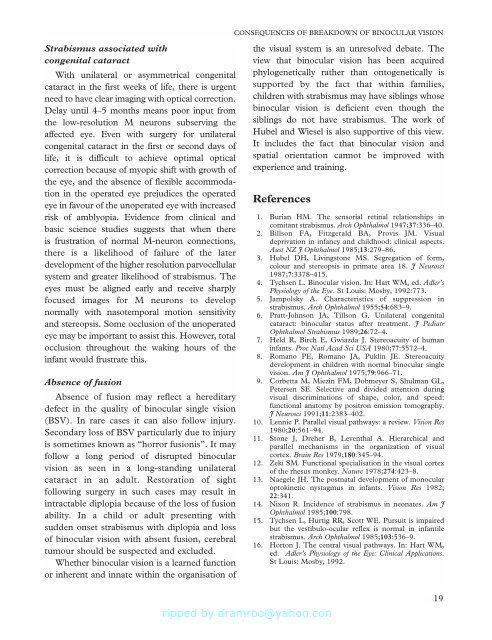Strabismus - Fundamentals of Clinical Ophthalmology.pdf
Strabismus - Fundamentals of Clinical Ophthalmology.pdf
Strabismus - Fundamentals of Clinical Ophthalmology.pdf
You also want an ePaper? Increase the reach of your titles
YUMPU automatically turns print PDFs into web optimized ePapers that Google loves.
CONSEQUENCES OF BREAKDOWN OF BINOCULAR VISION<br />
<strong>Strabismus</strong> associated with<br />
congenital cataract<br />
With unilateral or asymmetrical congenital<br />
cataract in the first weeks <strong>of</strong> life, there is urgent<br />
need to have clear imaging with optical correction.<br />
Delay until 4–5 months means poor input from<br />
the low-resolution M neurons subserving the<br />
affected eye. Even with surgery for unilateral<br />
congenital cataract in the first or second days <strong>of</strong><br />
life, it is difficult to achieve optimal optical<br />
correction because <strong>of</strong> myopic shift with growth <strong>of</strong><br />
the eye, and the absence <strong>of</strong> flexible accommodation<br />
in the operated eye prejudices the operated<br />
eye in favour <strong>of</strong> the unoperated eye with increased<br />
risk <strong>of</strong> amblyopia. Evidence from clinical and<br />
basic science studies suggests that when there<br />
is frustration <strong>of</strong> normal M-neuron connections,<br />
there is a likelihood <strong>of</strong> failure <strong>of</strong> the later<br />
development <strong>of</strong> the higher resolution parvocellular<br />
system and greater likelihood <strong>of</strong> strabismus. The<br />
eyes must be aligned early and receive sharply<br />
focused images for M neurons to develop<br />
normally with nasotemporal motion sensitivity<br />
and stereopsis. Some occlusion <strong>of</strong> the unoperated<br />
eye may be important to assist this. However, total<br />
occlusion throughout the waking hours <strong>of</strong> the<br />
infant would frustrate this.<br />
Absence <strong>of</strong> fusion<br />
Absence <strong>of</strong> fusion may reflect a hereditary<br />
defect in the quality <strong>of</strong> binocular single vision<br />
(BSV). In rare cases it can also follow injury.<br />
Secondary loss <strong>of</strong> BSV particularly due to injury<br />
is sometimes known as “horror fusionis”. It may<br />
follow a long period <strong>of</strong> disrupted binocular<br />
vision as seen in a long-standing unilateral<br />
cataract in an adult. Restoration <strong>of</strong> sight<br />
following surgery in such cases may result in<br />
intractable diplopia because <strong>of</strong> the loss <strong>of</strong> fusion<br />
ability. In a child or adult presenting with<br />
sudden onset strabismus with diplopia and loss<br />
<strong>of</strong> binocular vision with absent fusion, cerebral<br />
tumour should be suspected and excluded.<br />
Whether binocular vision is a learned function<br />
or inherent and innate within the organisation <strong>of</strong><br />
the visual system is an unresolved debate. The<br />
view that binocular vision has been acquired<br />
phylogenetically rather than ontogenetically is<br />
supported by the fact that within families,<br />
children with strabismus may have siblings whose<br />
binocular vision is deficient even though the<br />
siblings do not have strabismus. The work <strong>of</strong><br />
Hubel and Wiesel is also supportive <strong>of</strong> this view.<br />
It includes the fact that binocular vision and<br />
spatial orientation cannot be improved with<br />
experience and training.<br />
References<br />
1. Burian HM. The sensorial retinal relationships in<br />
comitant strabismus. Arch Ophthalmol 1947;37:336–40.<br />
2. Billson FA, Fitzgerald BA, Provis JM. Visual<br />
deprivation in infancy and childhood: clinical aspects.<br />
Aust NZ J Ophthalmol 1985;13:279–86.<br />
3. Hubel DH, Livingstone MS. Segregation <strong>of</strong> form,<br />
colour and stereopsis in primate area 18. J Neurosci<br />
1987;7:3378–415.<br />
4. Tychsen L. Binocular vision. In: Hart WM, ed. Adler’s<br />
Physiology <strong>of</strong> the Eye. St Louis: Mosby, 1992:773.<br />
5. Jampolsky A. Characteristics <strong>of</strong> suppression in<br />
strabismus. Arch Ophthalmol 1955;54:683–9.<br />
6. Pratt-Johnson JA, Tillson G. Unilateral congenital<br />
cataract: binocular status after treatment. J Pediatr<br />
Ophthalmol <strong>Strabismus</strong> 1989;26:72–4.<br />
7. Held R, Birch E, Gwiazda J. Stereoacuity <strong>of</strong> human<br />
infants. Proc Natl Acad Sci USA 1980;77:5572–4.<br />
8. Romano PE, Romano JA, Puklin JE. Stereoacuity<br />
development in children with normal binocular single<br />
vision. Am J Ophthalmol 1975;79:966–71.<br />
9. Corbetta M, Miezin FM, Dobmeyer S, Shulman GL,<br />
Petersen SE. Selective and divided attention during<br />
visual discriminations <strong>of</strong> shape, color, and speed:<br />
functional anatomy by positron emission tomography.<br />
J Neurosci 1991;11:2383–402.<br />
10. Lennie P. Parallel visual pathways: a review. Vision Res<br />
1980;20:561–94.<br />
11. Stone J, Dreher B, Leventhal A. Hierarchical and<br />
parallel mechanisms in the organization <strong>of</strong> visual<br />
cortex. Brain Res 1979;180:345–94.<br />
12. Zeki SM. Functional specialisation in the visual cortex<br />
<strong>of</strong> the rhesus monkey. Nature 1978;274:423–8.<br />
13. Naegele JH. The postnatal development <strong>of</strong> monocular<br />
optokinetic nystagmus in infants. Vision Res 1982;<br />
22:341.<br />
14. Nixon R. Incidence <strong>of</strong> strabismus in neonates. Am J<br />
Ophthalmol 1985;100:798.<br />
15. Tychsen L, Hurtig RR, Scott WE. Pursuit is impaired<br />
but the vestibulo-ocular reflex is normal in infantile<br />
strabismus. Arch Ophthalmol 1985;103:536–9.<br />
16. Horton J. The central visual pathways. In: Hart WM,<br />
ed. Adler’s Physiology <strong>of</strong> the Eye: <strong>Clinical</strong> Applications.<br />
St Louis: Mosby, 1992.<br />
19










![SISTEM SENSORY [Compatibility Mode].pdf](https://img.yumpu.com/20667975/1/190x245/sistem-sensory-compatibility-modepdf.jpg?quality=85)





